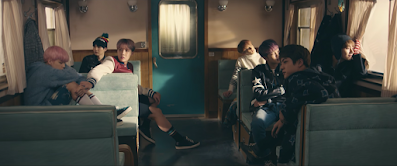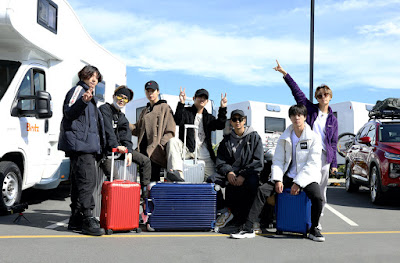In this blog post, we will share some of the customs and etiquette of South Korea. You wouldn't want to accidentally be disrespectful to your hosts or new friends.
We recommend that you read Korea: The Impossible Country by Daniel Tudor (available to purchase at all the usual websites) before you take your trip to South Korea. It really helped me understand South Korea and Koreans a lot more. You will also understand BTS more after reading this book like why they are so competitive and hard working, their use of honorifics and why even though Jungkook just turned 23 in September 2020 he's already 25 in Korea. This book covers religious foundations, cultural codes, politics, history, work/life balance etc. It definitely prepared me for my trip in 2019.The following advice is from Commisceo Global which specializes in cross-culture communication.
Naming Conventions:
- In South Korea names operate in the reverse of Western cultures; Family name (surname), a second family name shared by all of that generation, and finally their given name.
- It is considered very impolite to address a Korean with his or her given name. They should be addressed using their professional titles, or Mr, Mrs Etc, until permission is given otherwise.
- Ex: Min PD-nim, PD stands for producer
- Min Yoongi-ssi (more formal) or Yoongi-ssi (casual friends)
- Bowing is the traditional way to greet in South Korea
- Handshakes often accompany the bow among men
- Your left hand should support your right forearm when shaking hands
- Korean women do not always shake hands and may slightly nod instead of a full bow
- Always bow to individuals when departing
Communication Style:
- Good posture and positive body language is most beneficial in meetings; patience and politeness must be maintained throughout
- Do not use excessive or overt body language
- Use two hands, or support your right arm with your left, when passing on business cards, gifts, or when receiving an item
- Respect, trust and satisfaction are displayed through a deeper bow
Personal Space:
It is insulting for Koreans to be touched by someone with whom they are unfamiliar; don’t pat them on the back or hug them
Jimin & Suga doing skinship - Prolonged,
direct eye contact can be inferred as a challenge and is seen as
impolite, especially when dealing with others of a higher social standing - Keep your body within its own personal space; avoid extended or crossed legs and limit arm movements when explaining something so as to evade others’ personal space
- If calling someone over to you do not point with your index finger, instead use your hand palm down in a claw movement
- In cities (especially Seoul) pushing, shoving and touching are regular occurrences – don’t be offended by the lack of apologies
- Friends, of both sexes, will often walk arm in arm together, especially teenagers and the younger generations
- Skinship: In Korea, the term "skinship"
is used to describe the act of intimate, non-sexual touching between
very close (Usually same-sex, but can include both genders.) platonic friends. It involves acts such as holding hands/arms, hugging, and kissing on the cheeks.
Gift Giving Etiquette:
- Koreans are generous people and enjoy giving gifts
- Accept the gift with both hands – but never open the gift immediately, wait until the giver is absent
- Return the favor and offer something of a similar value. Koreans enjoy Western gifts and items so be prepared before leaving home
- If giving gifts be sure to wrap and present them in an attractive way. Avoid using dark wrapping paper, especially red, instead choose bright yellow/green
- If invited to a Korean home always take the hostess a gift; chocolates, sweets, cakes or flowers but preferably not alcohol
- Avoid gifts such as knives, scissors, sets of four, and red writing (these are seen as ‘cutting ties’ and signifying death respectively)
Dining, Drinking & Food
- Always wait to be seated by your host. If given the seat of honour (looking at the front door) it is polite to demonstrate a slight objection
- Elders are served first and begin the dining process
- Food and dining are important parts of Korean culture and are used to build relationships. Be sociable and work at shaping good associations for pleasure and business as they are interlinked
- Don’t pour your own drink, although it is considered good manners to pour another person's drink. Women often pour for men but not for other women. Rather than refuse more drink (remember, Koreans don’t like outright refusal) simply leave your glass part full, as opposed to empty
- Do not tip if you see a ‘no tipping’ sign
- There are often prolonged periods of silence during Korean meals – socializing can happen once everyone has feasted
- Don’t forget to pass and receive food with two hands or with just your right if it is supported by your left
- When it comes to settling the bill, the invitee may offer to pay but the host will generally pay for everyone.
If you are invited to continue after dinner with drinks or a party, don’t refuse this invitation.
V drinking soju - Do not point with your chopsticks, or leave them sticking out of your bowl
- The national drink of Korea is ‘Soju’, a clear vodka-like drink that is generally 18-25% alcohol
Visiting a home
- Always remove your shoes before entering a Korean home (in recent years there has been an increase in Western culture and this may not always be the case - follow the lead of your host if unsure)
- It is possible to arrive up to thirty minutes late without causing offense but punctuality is highly respected
- Remember, never pour your own drink. The host will do this in your presence
- Being invited into a Korean’s home is considered an honor (especially if it is for a meal) so it is essential to treat it as such. Be polite, respectful and observe their customs
- Bring a gift to reciprocate your host’s kindness
- Once the party is over you will usually be escorted to your car or the gate by the host. This is a sign of respect
Taboos in South Korean Culture
- Do not wear your shoes in places of worship or peoples’ homes
- Do not put your feet on furniture
- Do not eat or drink in public places while walking
- Do not place your thumb between your middle and index finger while making a fist as this an obscene gesture
- Do not use red ink. This is a symbol of death and is reserved only for writing the names of the deceased. It is considered unlucky and suggests you wish death to the recipient
- Do not use the number four if at all possible – if giving gifts, do not give four of something. It is considered unlucky due to the similarity between the Korean word for death and the pronunciation of the word ‘four’
- Do not stand too close to people you are meeting for the first time – keep an arms length between you










